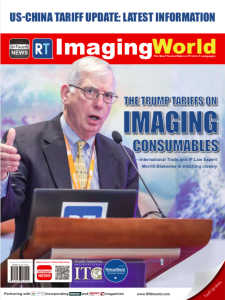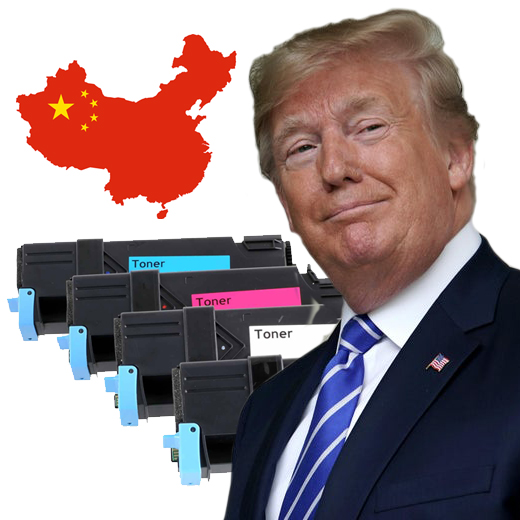The Trump Tariffs on Imaging Consumables
 Editor: The Trump Tariffs on Imaging Consumables
Editor: The Trump Tariffs on Imaging Consumables
Download our special 8-page extract edition featuring author, speaker and US trade attorney Merritt Blakeslee on the front cover
For more than a year, the news about an end to the Sino-U.S. trade has fluctuated weekly, often daily, between optimism and pessimism, with a resolution one day imminent and the next remote. While tariffs are typically imposed to achieve trade-related policy objectives, President Trump’s administration has been unusual in its aggressive use of tariffs to attempt to obtain concessions from the United States’ trading partners on non-trade-related policy issues. These tariffs presently impose additional duties on all imaging consumables and components imported into the United States from China.
A. Section 301 Tariffs on China
The U.S.’s most aggressive use of tariffs to achieve non-trade objectives are the tariffs levied on goods from China in 2018 under Section 301 of the Trade Act of 1974 (“Section 301 tariffs”). In 2017, the USTR conducted an investigation of Chinese trade practices and concluded that China:
- Steals U.S. intellectual property,
- Forces the transfer of U.S. intellectual property to Chinese enterprises, and
- Evades U.S. export controls to order to invest in strategic U.S. technology.
To compel China to change these practices, the United States opened a trade war by imposing successive rounds of tariffs on goods imported to the U.S. from China.
The following statistics help to put the magnitude of Sino-U.S. trade war in context. China is the largest export economy in the world, and the U.S. is China’s largest export market. In 2016, China’s exports to the U.S. represented 19% of all Chinese exports. In other words, U.S. tariffs that reduce the flow of Chinese exports have the potential to inflict significant economic harm on the Chinese manufacturers and exporters.
From a U.S. perspective, China is the U.S.’s largest supplier of goods imports, representing 21% of all U.S. imports. In addition, it is the U.S.’s third largest export market (after Canada and Mexico). In 2016, U.S. exports to China represented 9.2% of all U.S. exports. Thus, the Section 301 tariffs impose a significant economic penalty on U.S. consumers and industrial customers who purchase imported Chinese goods and an additional penalty on U.S. producers and exporters whose sales to China have been curtailed by the retaliatory tariffs that China has imposed.
The U.S. believes that it can win a trade war of attrition because its economy is stronger than China’s. China believes it must defend its trade policies and its increasing stature in the international trade economy and in geopolitics. While the trade war plays out, consumers and producers in both countries are suffering.
On March 22, 2018, the U.S. announced plans under Section 301 of the Trade Act of 1974 to:
- impose an additional 25% tariffs on $50 billion of Chinese imports,
- initiate a WTO dispute against China challenging its allegedly discriminatory regulations in the licensing of technology from non-Chinese to Chinese firms, and
- limit Chinese investments into the US.
The new tariffs pertain only to imports from China to the United States. However, they apply in addition to any normal duties, antidumping and countervailing duties, or other import charges on these Chinese products. At present, the United States has imposed four successive rounds of Section 301 tariffs, which, when completely implemented in December 2019, will cover virtually all products imported into the United States from China.
Round 1 tariffs ($34 billion): The first round of U.S. tariffs, which became effective July 6, 2018, targets $34 billion in Chinese imports. It imposes a 25% tariff on goods covered by 818 Harmonized Tariff Schedule (“HTS”) subheadings.
Round 2 tariffs ($16 billion): The second round of Section 301 tariffs, which became effective August 23, 2018, targets an additional $16 billion in Chinese imports. It too imposes a 25% tariff rate and covers goods imported under an additional 279 HTS subheadings.
Round 3 tariffs ($200 billion): The third round of Section 301 tariffs, which became effective September 24, 2018, targets an additional $200 billion in Chinese imports at an initial tariff rate of 10 percent. On May 9, 2019, the duty rate was increased to 25 percent. The third round of tariffs cover goods imported under an additional 5,745 HTS subheadings.
Round 4 tariffs ($300 billion): On August 1, 2019, President Trump announced that the United States would impose a 10% tariff on $300 billion worth of Chinese-made products beginning on September 1st, and suggested that the tariff rate could later be raised to 25%.
Extending the Section 301 tariffs to this additional $300 billion worth of goods will impose tariffs on virtually all goods from China that come into the United States.
On August 14th, the USTR, which administers the Section 301 tariffs, announced that a portion of the tariffs, most covering consumer items like laptops and smartphones, would be delayed until December 15th so as not to interfere with Christmas season buying in the United States. The tariffs delayed until December 15th cover about $189 billion in Chinese imports. Those that took effect on September 1st cover about $111 billion.
B. How the Section 301 Tariffs affect the importation of Chinese-origin ink and toner cartridges and components into the United States
Imaging consumables are covered by the Section 301 tariffs imposed on all four rounds. In the Harmonized Tariff Schedule, imaging consumables are covered by HTS 8443.99, which is divided into four main sections. Each of these sections covers both finished ink and toner cartridges and cartridge components:
- Parts and accessories of printers (8443.99.20 & 25)
- Parts and accessories of facsimile machines (8443.99.30 & 35)
- Parts and accessories of copying machines (8443.99.40 & 45)
- Other (i.e., parts and accessories of “universal,” multi-function, or three-in-one machines) (8443.99.50).
In addition, circuit boards used in ink and toner cartridges are classified under HTS 8542.31.00.01
Here is how the Section 301 tariffs apply to each of these product categories:
- Fax machine-only cartridges and components: An ink or toner cartridge can only be used in a fax machine is classified under HTS 8443.99.30. Components of such a cartridge are classified under HTS 8443.99.35. Such cartridges and components are subject to Round 3 of the Section 301 tariffs, which became effective September 24, 2018 at a duty rate of 10% ad valorem. The duty rate was increased to 25% ad valorem effective May 9, 2019.
- Copying machine-only cartridges and components: An ink or toner cartridge that can only be used in a copying machine is classified under HTS 8443.99.40 and is subject to Round 2 of the Section 301 tariffs, which became effective August 23, 2018 at a duty rate of 25% ad valorem. Components of a cartridge that can only be used in a copying machine are classified under HTS 8443.99.45 and are subject to Round 1 of the Section 301 tariffs, which became effective July 6, 2018 at a duty rate of 25% ad valorem.
- Cartridges and components for multifunction printers: If the same ink or toner cartridge, or a component of such a cartridge, can be used in a 3-in-1 or multifunction printer that performs at least two functions from among printing, faxing, and copying (or if the cartridge or its component can be used in at least two of a printer, fax machine, and copier), it is classified under HTS 8443.99.50. Cartridges and components for multi-function printers are subject to Round 4 of the Section 301 tariffs, which became effective September 1, 2019 at a duty rate of 10% ad valorem.
- Printer-only cartridges and components: An ink or toner cartridge that can only be used in a printer is classified under HTS 8443.99.20. In addition, components for a printer-only cartridge are classified under HTS 8443.99.20 if they fall within one of the following:
-
(c) Laser imaging assemblies, incorporating more than one of the following: photoreceptor belt or cylinder, toner receptacle unit, toner developing unit, charge/discharge units, cleaning unit;
-
(e) Ink jet marking assemblies, incorporating more than one of the following: thermal print head, ink dispensing unit, nozzle and reservoir unit, ink heater.
In other words, for a component of a printer-only cartridge to be classified under HTS 8443.99.20, it must constitute an “assembly” as described above. An individual component of a printer-only cartridge that is not an “assembly” is classified under HTS 8443.99.25. For example, a toner receptacle unit imported separately is classified under HTS 8443.99.25. If imported as part of a larger laser imaging assembly, on the other hand, it is classified under HTS 8443.99.20.
Printer-only cartridges and components that are classified under HTS 8443.99.20 are subject to Round 1 of the Section 301 tariffs, which became effective July 6, 2018 at a duty rate of 25% ad valorem.
Printer-only components that are classified under HTS 8443.99.25 are subject to Round 4 of the Section 301 tariffs, which became effective September 1, 2019 at a duty rate of 10% ad valorem.
-
- Circuit boards for ink and toner cartridges: Circuit boards used in ink and toner cartridges are classified under HTS 8542.31.00.01 (“Electronic integrated circuits: Processors and controllers, whether or not combined with memories. . . .”). The HTS is clear that where an item could be classified under 8542 and another HTS item (i.e., one of the 8443 line items), “heading . . . 8542 shall take precedence over any other heading in the [the HTS]” (HTS Ch. 85, Note 9). Such circuit boards are subject to Round 1 of the Section 301 tariffs, which became effective July 6, 2018 at a duty rate of 25% ad valorem.
- Recap of 301 Tariffs on Ink and Toner Cartridges: To summarize, all imaging consumables are subject to the Section 301 tariffs at a rate of 25% ad valorem except:
- individual components for printer-only cartridges (not including circuit boards) and
- cartridges and cartridge components (not including circuit boards) for multifunction printers,
which are subject to the Section 301 tariffs at a rate of 10% ad valorem. - (c) Laser imaging assemblies, incorporating more than one of the following: photoreceptor belt or cylinder, toner receptacle unit, toner developing unit, charge/discharge units, cleaning unit;
- (e) Ink jet marking assemblies, incorporating more than one of the following: thermal print head, ink dispensing unit, nozzle and reservoir unit, ink heater.
C. Exclusion requests
- Deadlines: A company whose imports fall under section 301 tariffs can request that a product it imports be “excluded” from the tariffs. If its exclusion request is granted, the excluded product, and all products like it, no matter who the producer or importer is, will be exempted from the 301 tariff on that product. The exclusion runs for a period of one year from the date on which it is granted. USTR has set no deadline for finishing ruling on the exclusion requests that have been submitted, but any granted request will be retroactive to the date on which that tariff was imposed. The deadline for filing exclusion requests for Round 1 was October 9, 2018. The deadline for filing exclusion requests for Round 2 was December 18, 2018. The deadline for filing Round 3 exclusion requests is September 30, 2019. USTR has promised to announce procedures for requesting exclusion from the Round 4 but as of the date of this writing (August 22, 2019) has not done so.
- Exclusion requests filed by the OEMs: USTR has provisionally approved the exclusion requests of three large OEMs covering printer-only cartridges and/or assemblies. These requests are presently being evaluated by Customs & Border Protection for “administrability.” If approved by CBP, they will be formally granted. The applicants include Canon U.S.A., Inc. (five requests), Konica Minolta Business Solutions U.S.A., Inc. (three requests), and Kyocera Document Solutions America Inc. (five requests). These submissions can be viewed on the https://www.regulations.gov website by entering docket number USTR-2018-0025 in the search field on the home page.
If granted, these exclusion requests apply not just to the applicant’s products but to any product that fits the product description in the exclusion notice, regardless of the identity of the producer or importer. Because exclusion requests are granted on a product-specific basis, a third party that does not obtain its own exclusion may, according to USTR, “still benefit from a product exclusion if a similar product is granted an exclusion.” In other words, it is possible that the importer of, for example, a remanufactured – or possibly even of a new-built compatible – Canon toner cartridge could benefit from any exclusion order that Canon eventually obtains.
Four companies that filed exclusion requests covering printer-only cartridges and/or assemblies had those requests denied: Epson America, Inc. (six requests), HP Inc. (seventeen requests), Xante Corporation (four requests), and Xerox Corporation (four requests). The Epson requests were denied by CBP on “administrability” grounds after having been preliminarily granted by USTR as having satisfied all the substantive criteria for an exclusion. Two companies that filed exclusion requests covering fax machine-only cartridges and/or components, Canon and Konica Minolta (one each), had those requests denied.
D. Mexican Tariffs
In late May, President Trump announced that the U.S. would impose broad tariffs on goods from Mexico unless Mexico agrees to do more to stop the flow of illegal immigrants into the United States. This was another dramatic use of tariffs to achieve a non-trade-related policy objective. The tariffs were to begin at 5% and to climb eventually to 25%. Within a matter of days, it was announced that the U.S. and Mexico had reached an agreement that eliminated the need for tariffs, at least for the time being. If tariffs on Mexico were to be imposed, that would seriously disrupt the business of U.S.-based cartridge producers and resellers who import cartridge components and finished cartridges from Mexico.
Disclaimer: This article is not intended to provide, and should not be relied on for legal advice on any particular set of fact. Anyone with a specific question about compliance with the Section 301 tariffs should consult a customs attorney or a customs broker.
Disclaimer: This article, Trump Tariffs on Imaging Consumables, is not intended to provide, and should not be relied on for, legal advice on any particular set of facts. Anyone with a specific question about compliance with the Section 301 tariffs should consult a customs attorney or a customs broker.







Leave a Comment
Want to join the discussion?Feel free to contribute!